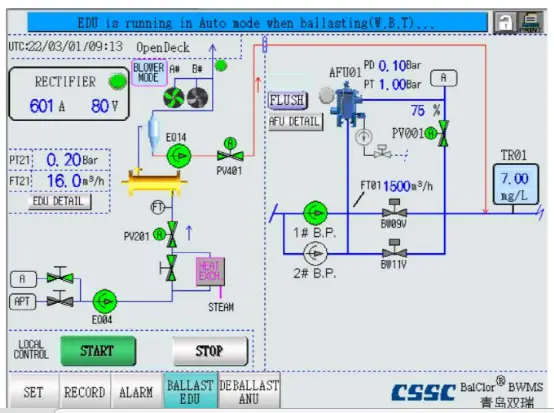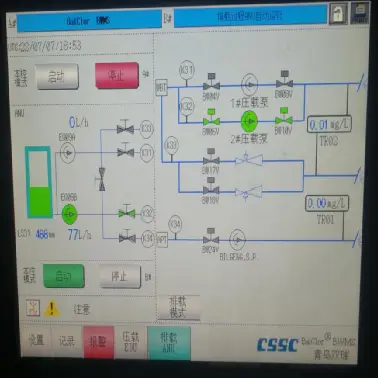Introduction
This guide explains how to manage ballast water on a ship using a SUNRUI ballast water treatment system, especially when operating with a single pump. The system is designed to handle 1500 cubic meters per hour, but the pump has a maximum flow of 1900 cubic meters per hour. Therefore, some valves are partially closed to limit the flow and maintain safe operation. Here’s a step-by-step guide for both loading (ballasting) and discharging (deballasting) water.
1. Ballasting with a Single Pump
Due to the ship’s design, only one pump can be used for ballasting. To make sure the system stays within safe limits, the inlet valve to the filter (HV001) is only partially opened. This restricts the flow to around 1500 cubic meters per hour, which is slightly under the pump’s maximum capacity of 1900 cubic meters per hour. Additionally, the intake valves for each ballast tank are also partially closed to make sure the water enters both tanks evenly.
During deballasting, two pumps can be used without any issues.

Valve Settings
- HV001: This valve controls the flow into the filter. When ballasting, open it to the marked position to limit the flow to around 1600 cubic meters per hour.
- PV001: This valve controls air pressure, keeping it above 5 kg/cm². It automatically adjusts when the ballast pump starts or stops.
2. How to Start the Ballast Mode
To start the ballast mode, follow these steps on the control screen:
- Select Ballast Mode: On the control panel, choose
BALLAST EDUand pressSTART. - Prepare the System: Open all relevant valves before starting the pump. If it takes too long, alarms may go off, and the system might stop automatically.
- Start the Pump: Once the system is ready, the pump can be turned on from the control room.

3. Operating the No. 1 Pump for Ballasting
Before you start:
- Ensure the EDU system and backwash system are ready, and relevant valves are open.
- Open the control air and check the valves K01, K02, HV001, and BW03.
- Open the TRO1 air valve and the sample valve K51 for the ballast and aft peak tanks.
4. Operating the No. 2 Pump for Ballasting
Steps are similar to the No. 1 pump:
- Open the control air and ensure the valves K03, K04, HV001, and BW07 are open.
- Open the TRO1 air valve and the sample valve K51 for the ballast and aft peak tanks.
5. Key Reminders
- The valves K01, K02, K03, K04, and HV001 are pre-set and do not need to be adjusted.
- Only one pump can be used for ballasting at a time.
- If the ballast pump stops, the EDU system will automatically stop. To restart, the system must be reset, and the pump restarted.
- Always check with the deck team to ensure water is flowing correctly.
6. Discharging (Deballasting) Procedure
- Select the Pump: Decide which pump you will use for discharging.
- Open the Control Air: Use TRO2 for sampling from ballast tanks and TRO1 for the aft peak tank. Open the sample valves accordingly.

7. Neutralizing the Water
When discharging, you need to open the correct valves in the neutralization unit (ANU):
- No. 1 Pump: This is linked to Unit A for sweeping the tanks.
- No. 2 Pump: This is linked to Unit B for the aft peak tank.
- Start the ANU pump from the control panel, and make sure all corresponding valves are open.
After starting the pump, go back to the control room to manage the operation. The fire pump is used for discharging the aft peak tank.
Note: During deballasting, make sure the seawater intake is open. While an alarm may sound, the system will keep running. However, neutralization will stop, and new chemicals will need to be prepared.
8. Freshwater Ballasting
Before starting freshwater ballasting, ensure the seawater storage tank (APT) has enough seawater. This water will be filtered before it enters the APT. To make sure the EDU system receives water from the APT and not from the ballast line, switch the relevant valves. Follow the ballasting procedure as usual after making these adjustments.
Conclusion
This guide simplifies the process of using the SUNRUI ballast water treatment system on a ship. By following the instructions above, you can safely and efficiently manage ballast and discharge operations, ensuring that the system runs smoothly.
